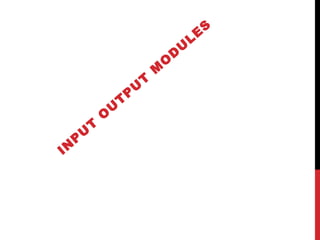
Input output module
- 2. INPUT/OUTPUT PROBLEMS Input / Output modules are the third critical element of the computer system (others are the CPU and the memory) All computer systems must have efficient means to receive input and deliver output Wide variety of peripherals (external devices) • Delivering different amounts of data • At different speeds • In different formats All slower than CPU and RAM Need I/O modules
- 3. GENERIC MODEL OF I/O MODULE
- 4. INPUT/OUTPUT MODULE External devices are not generally connected directly into the bus structure of the computer I/O module is an interface for the external devices (peripherals) to CPU and Memory
- 5. MODULE FUNCTION The major functions or requirements for an I/O module fall into the following categories: • Control and timing • Processor communication • Device communication • Data buffering • Error detection
- 6. CONTROL AND TIMING Requirement, to coordinate the flow of traffic between internal resources and external devices. For example, the control of the transfer of data from an external device to the processor might involve the following sequence of steps: 1. The processor interrogates the I/O module to check the status of the attached device. 2. The I/O module returns the device status. 3. If the device is operational and ready to transmit, the processor requests the transfer of data, by means of a command to the I/O module. 4. The I/O module obtains a unit of data (e.g., 8 or 16 bits) from the external device. 5. The data are transferred from the I/O module to the processor.
- 7. PROCESSOR COMMUNICATION Command decoding: The I/O module accepts commands from the processor, typically sent as signals on the control bus. e.g. magnetic disk. Data Data are exchanged between the processor and the I/O module over the data bus. Status reporting Because peripherals are so slow, it is important to know the status of the I/O module. Generates status signal. Busy or Ready. Address recognition Just as each word of memory has an address, so does each I/O device.
- 8. DEVICE COMMUNICATION Block diagram of external device
- 9. DATA BUFFERING The need for this function is apparent from this figure
- 10. CONT… The data are buffered in the I/O module and then sent to the peripheral device at its data rate. In the opposite direction, data are buffered so as not to tie up the memory in a slow transfer operation. Similarly, if the I/O device operates at a rate higher than the memory access rate, then the I/O module performs the needed buffering operation.
- 11. ERROR DETECTION I/O module is often responsible for error detection and for subsequently reporting errors to the processor. One class of errors includes mechanical and electrical malfunctions reported by the device. Another class consists of unintentional changes to the bit pattern as it is transmitted from device to I/O module. This can be detected through adding a parity bit. For example: the IRA character code occupies 7 bits of a byte.
- 13. I/O Module Structure -The module connects to the rest of the computer through a set of system bus lines. -Data transferred to and from the module are buffered in one or more data register. -One or more status register provide current status information. -A status register may also function as a control register, to accept detailed control information from the processor. -The logic within the module the module interacts with the processor via a set of control lines. -The processor uses the control lines to issue commands to the I/O module. -Some of the control lines may be used by the I/O module for status signal. -Each I/O module has a unique address or a unique set of addresses if it controls more than one external device.
- 14. CONT. i/o module may hide the details of timing, formats, and the electro mechanics of an external device so that the processor can function in terms of simple read and write commands, and possibly open and close file commands. in its simplest form, the i/o module may still leave much of the work of controlling a device (e.g., rewind a tape) visible to the processor.
- 15. CONT. An I/O module that takes on most of the detailed processing burden, presenting a high-level interface to the processor, is usually referred to as an I/O channel or I/O processor. An I/O module that is quite primitive and requires detailed control is usually referred to as an I/O controller or device controller. I/O controllers are commonly seen on microcomputers, whereas I/O channels are used on mainframes.
